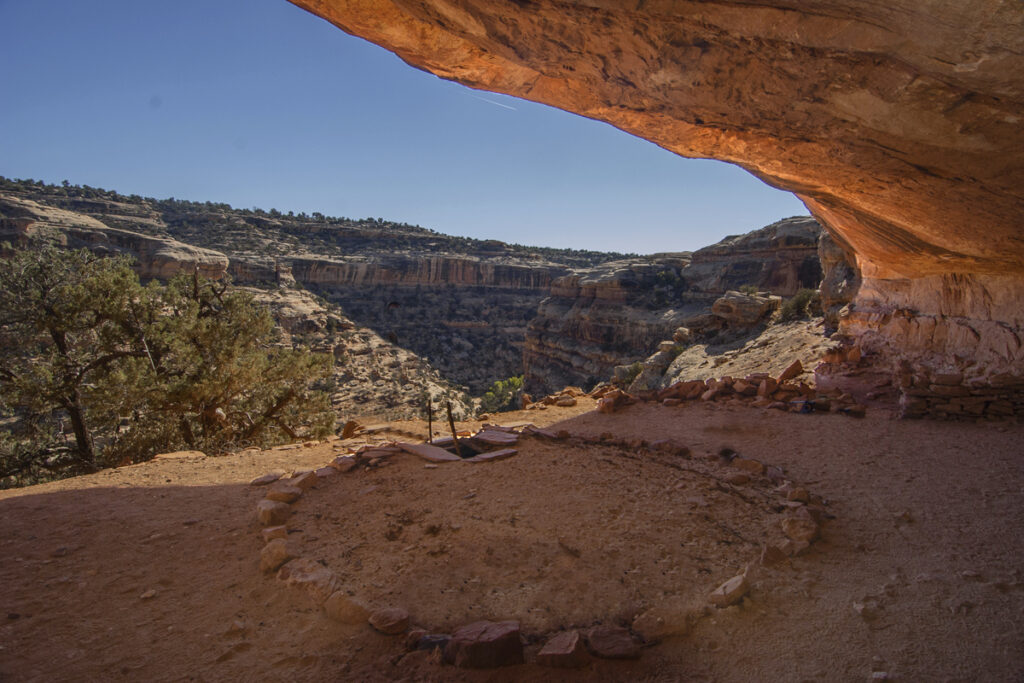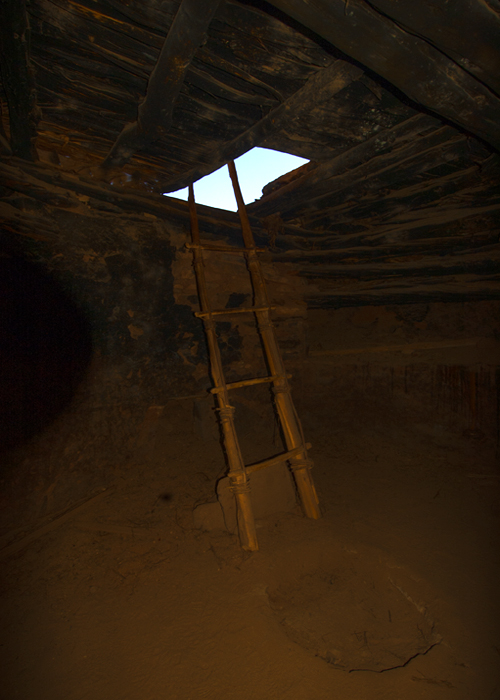Ray Rasmussen
Messages from Lost Worlds
Southwest USA. While hiking in the remote Slickhorn Canyon, we’ve spotted a large alcove partway up a sandstone cliff. “Might be a ruin in it,” Gary says. After a long climb, we arrive at a complex of stone and mud structures built by a people called Ancestral Puebloans—the forebears of the present-day Pueblo-peoples, Hopi, Zuni, and Acoma.
There were families living in these remote canyons for several thousand years until a century-long drought led to the abandonment of their homes and farms. Sometimes we find the remnants of their dwellings, but often there’s not much left of them but a pile of stones. “Rubble,” Inga calls them, with her rolled “R” german accent—as if they somehow don’t matter.
Finding ruins and rock art has become a kind of quest and it’s possible to walk all day in the beauty of these untouched canyons and feel disappointed if none are found. But not this time. Entering the high-ceiling alcove, we not only find several mud-stone buildings, but are happily surprised to also see a circle of stones at ground level. The top of a ladder is sticking up through a small opening in the middle. “It’s an intact kiva,” Nancy says. And I’m thinking, Not rubble, not disappointment—a ceremonial chamber, very special.

We climb down into the 10-foot-deep circular chamber, sit along the walls in darkness but for light coming through the entrance. It feels as if we’ve entered an ancient church and we’re determined to be as respectful as we are when visiting historic cathedrals back home.

A small indentation at the foot of the ladder is a Sipapu. Today’s Puebloans tell us they represent an entryway through which their ancestors escaped the ordeals of a previous world and came into this, their new world.
We have no idea what the ancient one’s ceremonies were like. Edward breaks the silence by softly singing, “What a Wonderful World” in a low, Louis Armstrong raspy voice, and we all join in:
I see skies of blue and clouds of white
The bright blessed day, the dark sacred night
And I think to myself, what a wonderful world
As we sing through all the verses, our voices resonate, and I gain a sense of the peace the Puebloans may have felt while performing their ceremonies. But as I look up through the small bright entryway, I think of the not-so-wonderful world I’ve left behind, climate change, political chaos, and yes, family troubles.
Back at the campsite, at our fireside gathering, Edward mentions that “Wonderful World” reminded him of an ancient prayer from the Inuit, a people who live to the far north of our homes in Canada, and he recites it for us:
I think over again my small adventures.
My fears,
Those small ones that seemed so big,
For all the vital things
I had to get and reach.
And yet there is only one great thing,
The only thing,
To live to see the great day that dawns
And the light that fills the world.
We take the song’s hint and share our concerns, the ones that seem “So big,” the ones each of us carries while walking through these meandering canyons.
Up early in a gold-lit dawn, we make plans for the day as we eat breakfast. Walt says, “I’d like to search the rest of Slickhorn Canyon for ruins.”
As we hike further along the striated sandstone walls, I wonder, how did “finding ruins” become a vital thing I feel I have to do while here? Why is it so difficult to simply enjoy the light filling this present world?
contrails in a blue sky . . .
forming and dissipating
through the day
Note:
“Prayer at a Time of Adversity” is from the Kitlinuharmiut (Copper Eskimo/Inuit), translated by Knud Rasmussen, attributed to The Report of the Fifth Thule Expedition 1921-24.
About the Author

Ray Rasmussen is retired and enjoys hiking, photography, and canoeing with his partner, Nancy. They reside in Halton Hills, Ontario, Canada. He previously served as editor in chief for Haibun Today and as an editor for several journals. His haiku, haiga, & haibun have appeared in numerous journals and anthologies. Ray’s collection of haibun Landmarks is found on Amazon. His haibun blog is https://rays-blog.ca/ And his photography and poetry website is http://raysweb.net.

Why is it so difficult to simply enjoy the light filling this present world?
A question I’ve been asking myself a lot lately.
Thank you for sharing this lovely piece.
Hi Terri,
I’m bothered most by the pronouncements that make it sound easy to “be present” and “enjoy what’s there.”
I don’t know why it’s difficult. I do find that walking help … the more I walk, the more the “out there” becomes present. I think my mind gets worn down.
Ray
A thoughtful piece of writing, Ray. It gives me pause this morning. With a big storm coming our way, wind, sirens warning of lightning, etc. I think of how often I miss the big picture, that beautiful light that rises for us each morning, another day, another opportunity to become whatever it is we are supposed to be. I enjoyed “It’s a Wonderful World,” the way it led to the Inuit prayer.
Thank you for this moment.
Thanks for the comments Mary Jo. Always nice to know the writing has connected with someone.